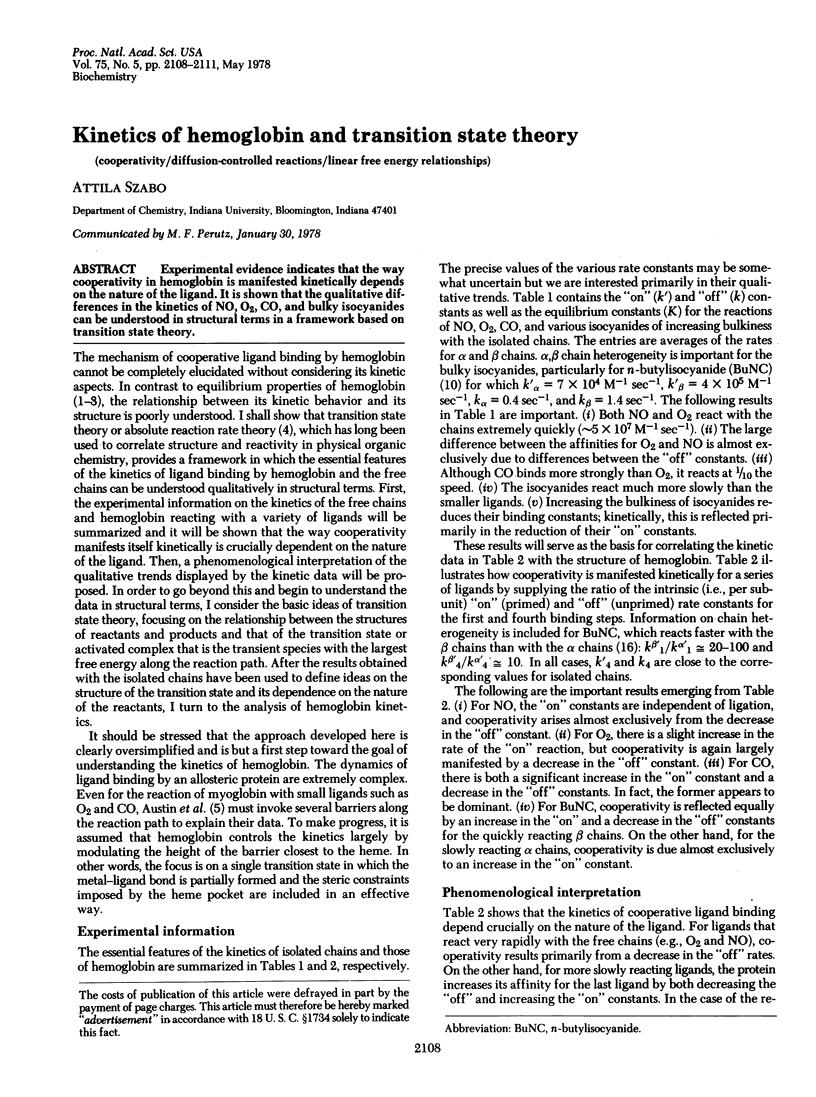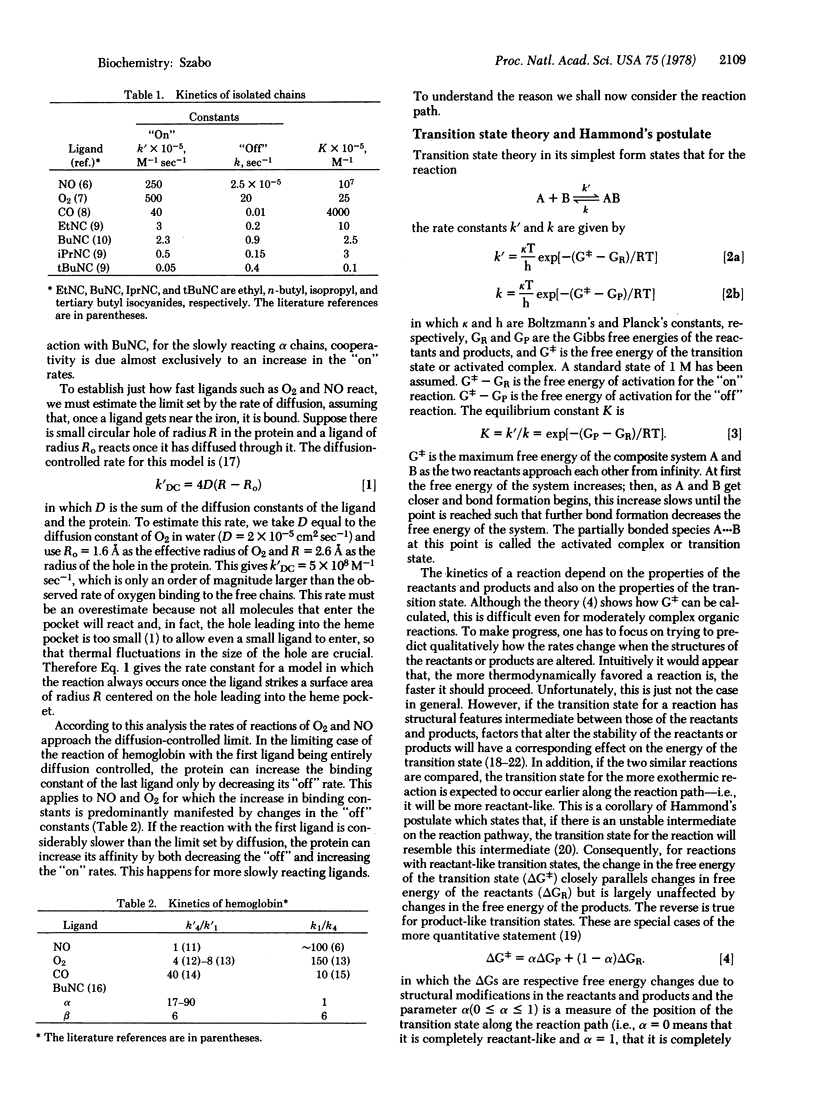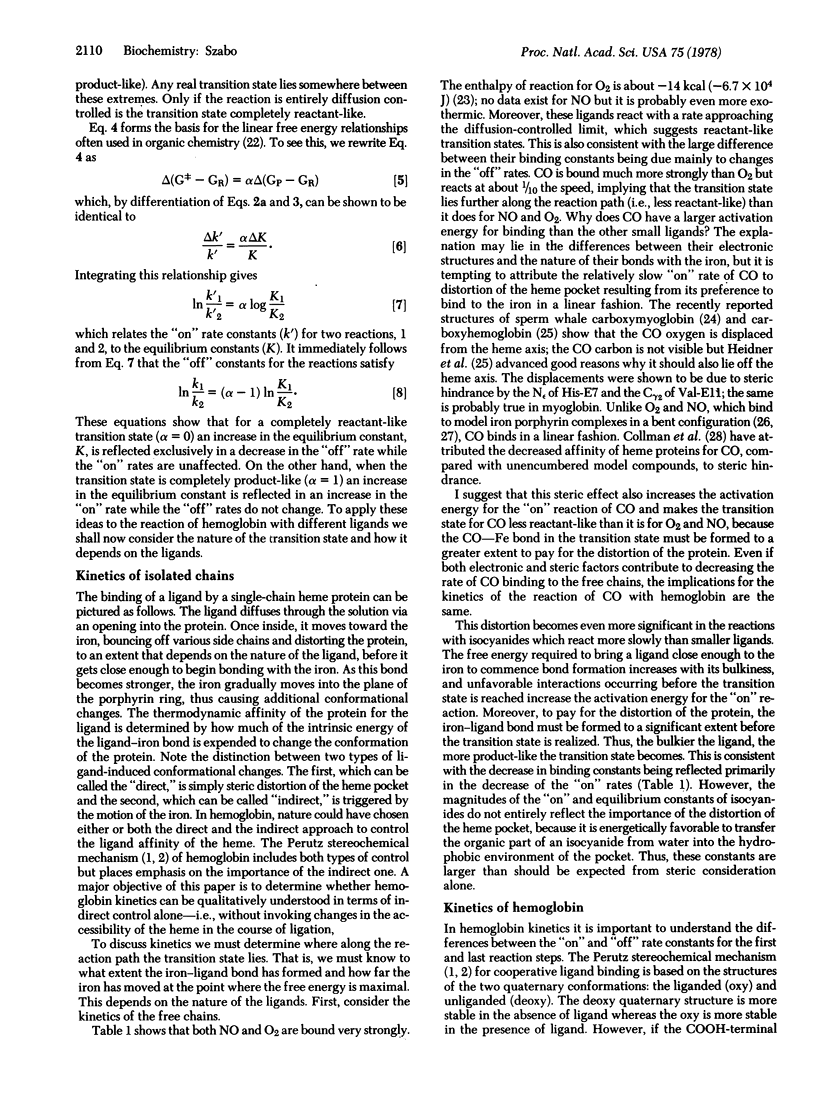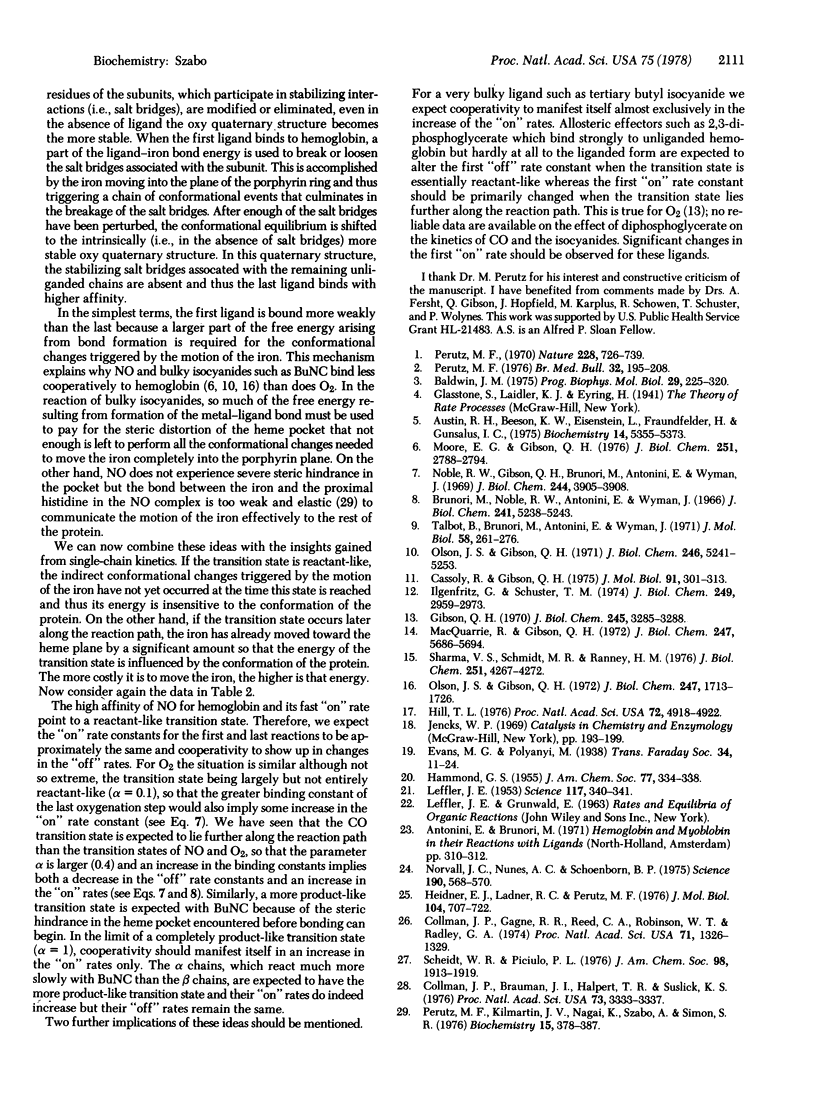Abstract
Experimental evidence indicates that the way cooperativity in hemoglobin is manifested kinetically depends on the nature of the ligand. It is shown that the qualitative differences in the kinetics of NO, O2, CO, and bulky isocyanides can be understood in structural terms in a framework based on transition state theory.
Full text
PDF



Selected References
These references are in PubMed. This may not be the complete list of references from this article.
- Austin R. H., Beeson K. W., Eisenstein L., Frauenfelder H., Gunsalus I. C. Dynamics of ligand binding to myoglobin. Biochemistry. 1975 Dec 2;14(24):5355–5373. doi: 10.1021/bi00695a021. [DOI] [PubMed] [Google Scholar]
- Baldwin J. M. Structure and function of haemoglobin. Prog Biophys Mol Biol. 1975;29(3):225–320. doi: 10.1016/0079-6107(76)90024-9. [DOI] [PubMed] [Google Scholar]
- Brunori M., Noble R. W., Antonini E., Wyman J. The reactions of the isolated alpha and beta chains of human hemoglobin with oxygen and carbon monoxide. J Biol Chem. 1966 Nov 25;241(22):5238–5243. [PubMed] [Google Scholar]
- Cassoly R., Gibson Q. Conformation, co-operativity and ligand binding in human hemoglobin. J Mol Biol. 1975 Jan 25;91(3):301–313. doi: 10.1016/0022-2836(75)90382-4. [DOI] [PubMed] [Google Scholar]
- Collman J. P., Brauman J. I., Halbert T. R., Suslick K. S. Nature of O2 and CO binding to metalloporphyrins and heme proteins. Proc Natl Acad Sci U S A. 1976 Oct;73(10):3333–3337. doi: 10.1073/pnas.73.10.3333. [DOI] [PMC free article] [PubMed] [Google Scholar]
- Collman J. P., Gagne R. R., Reed C. A., Robinson W. T., Rodley G. A. Structure of an iron(II) dioxygen complex; a model for oxygen carrying hemeproteins. Proc Natl Acad Sci U S A. 1974 Apr;71(4):1326–1329. doi: 10.1073/pnas.71.4.1326. [DOI] [PMC free article] [PubMed] [Google Scholar]
- Gibson Q. H. The reaction of oxygen with hemoglobin and the kinetic basis of the effect of salt on binding of oxygen. J Biol Chem. 1970 Jul 10;245(13):3285–3288. [PubMed] [Google Scholar]
- Heidner E. J., Ladner R. C., Perutz M. F. Structure of horse carbonmonoxyhaemoglobin. J Mol Biol. 1976 Jul 5;104(3):707–722. doi: 10.1016/0022-2836(76)90130-3. [DOI] [PubMed] [Google Scholar]
- Hill T. L. Effect of rotation on the diffusion-controlled rate of ligand-protein association. Proc Natl Acad Sci U S A. 1975 Dec;72(12):4918–4922. doi: 10.1073/pnas.72.12.4918. [DOI] [PMC free article] [PubMed] [Google Scholar]
- Ilgenfritz G., Schuster T. M. Kinetics of oxygen binding to human hemoglobin. Temperature jump relaxation studies. J Biol Chem. 1974 May 10;249(9):2959–2973. [PubMed] [Google Scholar]
- Leffler J. E. Parameters for the Description of Transition States. Science. 1953 Mar 27;117(3039):340–341. doi: 10.1126/science.117.3039.340. [DOI] [PubMed] [Google Scholar]
- MacQuarrie R., Gibson Q. H. Ligand binding and release of an analogue of 2,3-diphosphoglycerate from human hemoglobin. J Biol Chem. 1972 Sep 25;247(18):5686–5694. [PubMed] [Google Scholar]
- Moore E. G., Gibson Q. H. Cooperativity in the dissociation of nitric oxide from hemoglobin. J Biol Chem. 1976 May 10;251(9):2788–2794. [PubMed] [Google Scholar]
- Noble R. W., Gibson Q. H., Brunori M., Antonini E., Wyman J. The rates of combination of the isolated chains of human hemoglobin with oxygen. J Biol Chem. 1969 Jul 25;244(14):3905–3908. [PubMed] [Google Scholar]
- Norvell J. C., Nunes A. C., Schoenborn B. P. Neutron diffraction analysis of myoglobin: structure of the carbon monoxide derivative. Science. 1975 Nov 7;190(4214):568–570. doi: 10.1126/science.1188354. [DOI] [PubMed] [Google Scholar]
- Olson J. S., Gibson Q. H. The reaction of n-butyl isocyanide with human hemoglobin. I. Determination of the kinetic parameters involved in the last step in ligand binding. J Biol Chem. 1971 Sep 10;246(17):5241–5253. [PubMed] [Google Scholar]
- Olson J. S., Gibson Q. H. The reaction of n-butyl isocyanide with human hemoglobin. II. The ligand-binding properties of the and chains within deoxyhemoglobin. J Biol Chem. 1972 Mar 25;247(6):1713–1726. [PubMed] [Google Scholar]
- Perutz M. F., Kilmartin J. V., Nagai K., Szabo A., Simon S. R. Influence of globin structures on the state of the heme. Ferrous low spin derivatives. Biochemistry. 1976 Jan 27;15(2):378–387. doi: 10.1021/bi00647a022. [DOI] [PubMed] [Google Scholar]
- Perutz M. F. Stereochemistry of cooperative effects in haemoglobin. Nature. 1970 Nov 21;228(5273):726–739. doi: 10.1038/228726a0. [DOI] [PubMed] [Google Scholar]
- Perutz M. F. Structure and mechanism of haemoglobin. Br Med Bull. 1976 Sep;32(3):195–208. doi: 10.1093/oxfordjournals.bmb.a071363. [DOI] [PubMed] [Google Scholar]
- Scheidt W. R., Piciulo P. L. Nitrosylmetalloporphyrins. III. Synthesis and molecular stereochemistry of nitrosyl-alpha, beta, gamma, delta-tetraphenylporphinato(1-methylimidazole)iron(II). J Am Chem Soc. 1976 Mar 31;98(7):1913–1919. doi: 10.1021/ja00423a044. [DOI] [PubMed] [Google Scholar]
- Sharma V. S., Schmidt M. R., Ranney H. M. Dissociation of CO from carboxyhemoglobin. J Biol Chem. 1976 Jul 25;251(14):4267–4272. [PubMed] [Google Scholar]
- Talbot B., Brunori M., Antonini E., Wyman J. Studies on the reaction of isocyanides with haemproteins. I. Equilibria and kinetics of the binding to the isolated chains of human haemoglobin. J Mol Biol. 1971 May 28;58(1):261–276. doi: 10.1016/0022-2836(71)90245-2. [DOI] [PubMed] [Google Scholar]


